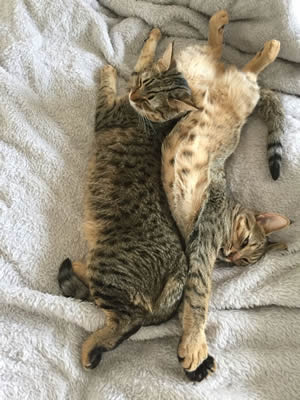Breed Standard
Head: The head is usually-pear shaped. Tipped ears, heavy ear hair, black lips, and . Their chins have white fur, but often have black skin under the white fur. Some of their whiskers change from Black (root - about 25%) to White (to the tip - about 75% of the whisker).
Eyes: White fur around the eyes but with black eye skin. Eyes are blue when kittens, then change to green, and finally to gold when several months old (some don't change completely to gold, but have gold with a green tint). Eyes are almond shaped and tilted.
Body: Pixie-Bobs are approximately 50% larger than most domestic cats (which weigh 5.5-16 lb or 2.5-7 kg).
Paw: Most Pixie-Bobs have black fur and skin on the bottom of their paws
Tail: Tails can be non-existent (rumpy), or 2-4 inches (desired - TICA required), or long tails (Pixie was a long tail).
Coat: Tiger-like fur pattern. Stomach is often reddish-gold in color with some ticking (broken stripes). Most are short-haired, but some are long-haired. They grow for 3 years instead of 1 year like most domestic cats.
History
In 1985, Carol Ann Brewer, a breeder in Washington state, had a female cat named Pixie who was polydactyl (with more toes than normal). After mating, possibly with a small bobcat, Pixie produced a litter in which some kittens resembled the father (spotted coat, broad ears, etc.). They were called Pixie Bobs. The new breed was recognized by T.I.C.A., which published a standard in 1998.
Behavior
Intelligence, loyalty, affectionate, companionable, loving, trustworthy, tractable, dog like devotion, great companions, and strongly bonding with their human family are depictions of their calm temperament.
Health
The breed has no known health problems. However, Pixie-Bobs are extremely sensitive to vaccines. It has been recommend that feeding meat in addition to commercial foods provides the nutrition these cats require to grow to their full size potential.






